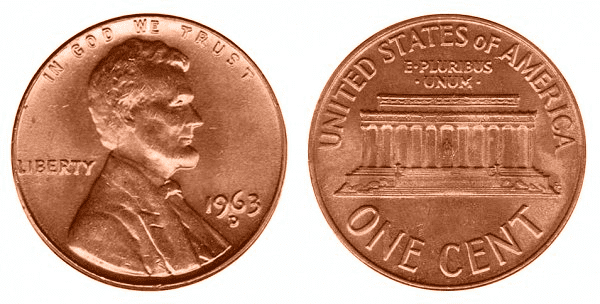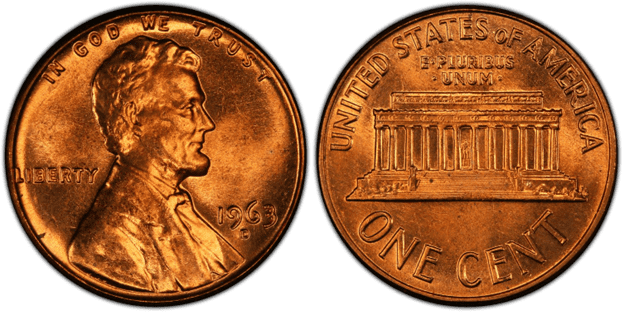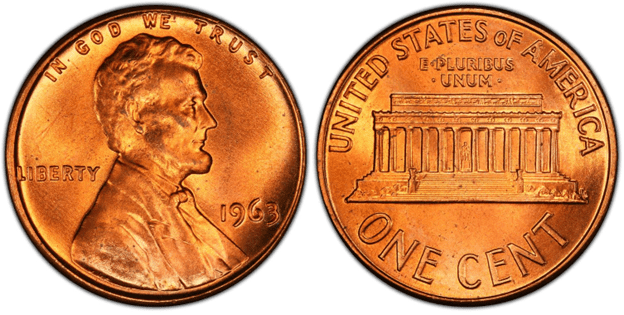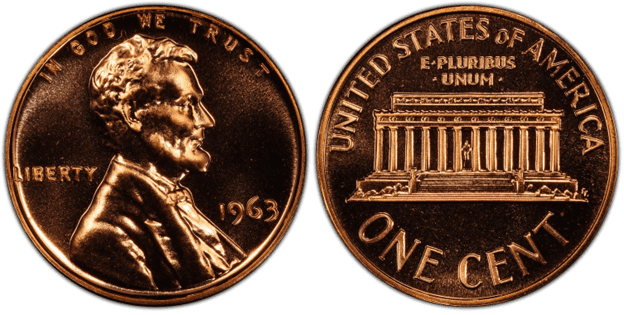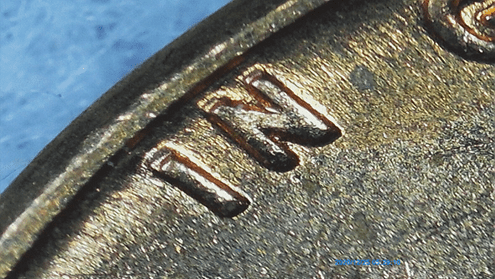What Is the 1963 Lincoln Penny Made Of?
The 1963 Lincoln penny is made of 95% copper while the remainder is 5% tin or zinc. The same composition is used for Lincoln pennies made from 1909 to 1942 and from 1944 to 1982. Then, from 1982 to the present, the Lincoln penny is made of 97.5% zinc and 2.5% copper.
The Lincoln penny was first struck in 1909. At that time, the reverse features two stalks of wheat. That’s the reason why Lincoln pennies from 1909 to 1958 were commonly referred to as “wheat pennies.”
After 1958, the reverse was redesigned to depict the front view of the Lincoln Memorial. The design was used until 2010 when the reverse was changed to the Union Shield by Lyndall Bass.
To learn more about the 1963 Lincoln penny, here are some of its specifications:
- Value: 1 cent
- Mass: 2.5 g
- Diameter: 19.05 mm
- Edge: Plain
- Years of minting: 1909 up to present
The 1963 Lincoln penny was designed by two artists. The obverse was designed by Victor David Brenner and the reverse was designed by Frank Gasparro.
Designers were allowed to add their initials to the design. However, when the Lincoln penny was released in 1909, Brenner’s initials, which is VDB, were seen to be too big that it was hard to look at the coin without seeing the initials. As a result, the initials were removed just after a few days.
The initials of Brenner would then be restored in 1918, this time, the initials were smaller.
It’s quite interesting to note that Brenner wasn’t really the first choice for the design. Originally, it was Augustus Saint-Gaudens who was tasked to do it. However, he died in August 1907 before finishing the project.
The obverse includes the image of Abraham Lincoln, facing right. On top of his head is the inscription IN GOD WE TRUST, inscribed in an arching manner. On his left is the word “LIBERTY,” which is one of the most important founding principles of the United States. In front of him is the year of the series, which is 1963.

photo source: USA Coin Book
The reverse, as mentioned, has the Lincoln Monument. Inscriptions include the following:
- UNITED STATES oF AMERICA
- E PLURIBUS UNUM (Latin for “Out of many, one.”)
- ONE CENT
The year 1909, which was the year when the Lincoln penny was first struck, was the same centennial year of Lincoln’s birth. So the timing of adding Lincoln to the coin was just right.
The general sentiment of the public prior to that time was that having a US president on a coin felt like it is too monarchical. That’s why, when Lincoln’s face was added to the US penny, some doubted that it might not be well-received by the people.
However, the Lincoln penny became the first and most widely issued US coin with a president’s face. There was great public interest and so, the Lincoln penny set the way for other coins to feature presidents.
1963 Lincoln Penny Varieties
The 1963 Lincoln cent or penny has three official varieties issued by the U.S. Mint. These are the 1963 P, 1963 proof, and 1963 D Lincoln pennies. There were a total of over 2.5 billion pennies struck in 1963.
Aside from the standard varieties, there are error penny coins, which gave rise to a different and new variety.
Take a look below to know more about the 1963 Lincoln penny varieties:
1963 D Lincoln Penny
Year of minting: 1963
Mint Mark: D
Place of minting: Denver
Quantity produced: 1,774,020,400
Face Value: $0.01 (one cent)
Price: $0.01 to $7.00 (or more)
Mass: 2.5 grams
Edge: Plain
Designer: Victor D. Brenner (obverse) / Frank Gasparro (reverse)
Composition: 95% copper and 5% tin or zinc
Diameter: 19.05 mm
Thickness: 1.52 mm

photo source: PCGS
The Denver Mint produced more than 1.7 billion 1963 D pennies. You can buy one of these for about $0.01 to $7.00 if the coin is in circulated condition. The price can be higher if it is favorably graded.
1963 P Lincoln Penny
Year of minting: 1963
Mint Mark: None
Place of minting: Philadelphia
Quantity produced: 754,110,000
Face Value: $0.01 (one cent)
Price: $0.01 to $9.00 (or more)
Mass: 2.5 grams
Edge: Plain
Designer: Victor D. Brenner (obverse) / Frank Gasparro (reverse)
Composition: 95% copper and 5% tin or zinc
Diameter: 19.05 mm
Thickness: 1.52 mm

photo source: PCGS
The Philadelphia Mint produced more than 754 million Lincoln pennies in 1963. Its price can start from $0.01 to $9.00. Rare and unique coins can be more expensive.
1963 S Lincoln Penny
Year of minting: 1963
Mint Mark: S
Place of minting: Philadelphia
Quantity produced: 3,075,645
Face Value: $0.01 (one cent)
Price: $0.01 to $7.00 (or more)
Mass: 2.5 grams
Edge: Plain
Designer: Victor D. Brenner (obverse) / Frank Gasparro (reverse)
Composition: 95% copper and 5% tin or zinc
Diameter: 19.05 mm
Thickness: 1.52 mm

photo source: PCGS
The Philadelphia Mint isn’t known for producing proof coins today. However, in the past, it was the primary source of proof coins.
The proof coins are shinier, more detailed, and more beautiful than other types of coins. The reason behind this is that proof coins are specially made for collectors.
In 1963, there were more than 3 million proof Lincoln pennies. The price tag most people give is around $0.01 to $7.00.
List of 1963 Lincoln Penny Errors
With billions of 1963 Lincoln pennies, it’s just a matter of time before some coins will be made with errors. Although it may sound negative, a lot of collectors are fond of error coins because of their uniqueness and rarity.
Error coins happen due to different reasons. Here are some of the most common ones:
- Mechanical failure
- Wear and tear of the minting equipment
- Break in the die
- Misalignment in the die and planchet placement
- Incorrect cutting of planchet
- Human error
- Foreign materials got into the minting process
- The coin was struck more than once
A lot of coins get doubled die strikes. This means the planchet was struck twice. This leads to the doubling of some engraved elements on the coin.
Here’s an example:

photo source: eBay
Sometimes, the error isn’t that obvious. You have to look closely. Experts would even use a microscope or magnifying glass to identify the error.
How Much Is the 1963 Lincoln Penny Worth Today?
A circulated 1963 Lincoln penny might just be worth as much as its face value, which is $0.01. The melt value of the 1963 penny is $0.0251. Looking at these prices, you might think that your coin isn’t that valuable.
However, if you have rare, unique, and beautiful 1963 Lincoln pennies, then you might be looking at an expensive coin.
To give you an idea, here’s a 1963 Lincoln Penny values chart for your to compare coins:
| Coin | Condition | Grade | Mintage | Value |
| 1963 D Lincoln penny | Circulated/mint | Not graded | 1,774,020,400 | $0.01 to $7.00 |
| 1963 D Lincoln penny | Uncirculated/mint | MS-65 | 1,774,020,400
|
$7 to $20 |
| 1963 D Lincoln penny | Uncirculated/mint | MS-66 | 1,774,020,400
|
$31 to $141 |
| 1963 D Lincoln penny | Uncirculated/mint | MS-67 | 1,774,020,400
|
$489 to $2,820 |
| 1963 P Lincoln penny | Circulated/mint | Not graded | 754,110,000 | $0.01 to $9.00
|
| 1963 P Lincoln penny | Uncirculated/mint | MS-65 | 754,110,000 | $6 to $7 |
| 1963 P Lincoln penny | Uncirculated/mint | MS-66 | 754,110,000 | $13 to $35 |
| 1963 P Lincoln penny | Uncirculated/mint | MS-67 | 754,110,000 | $306 to $1,500 |
| 1963 Proof Lincoln penny | Circulated/proof | Not graded | 3,075,645 | $0.01 to $7.00 |
| 1963 Proof Lincoln penny | Uncirculated/proof | PR-64 | 3,075,645 | $7 |
| 1963 Proof Lincoln penny | Uncirculated/proof | PR-65 | 3,075,645 | $25 |
| 1963 Proof Lincoln penny | Uncirculated/proof | PR-66 | 3,075,645 | $6 to $15 |
How Does The Grading System Work?
The Sheldon Scale is used by numismatists to provide a numerical value to coins. The Sheldon Scale goes from poor (P-1) to perfect mint state (P-1) (MS-70). Coins were originally evaluated using words to reflect their condition (Good, Fair, Excellent, Etc.). Unfortunately, coin collectors and dealers had different ideas about what each of these terms represent.
Professional numismatists joined together in the 1970s and established CoinGrading standards. These numismatists now assign grades at key places on the seventy-point scale, using the most regularly utilized numeric points in conjunction with the original adjective grade. The following are the most common coin grades:
-
-
- (P-1) Poor – Indistinguishable and probably damaged; if used, must have a date and mintmark; otherwise, rather battered.
- (FR-2) Fair – Nearly smooth, but without the damage that a coin graded Poor often possesses. The coin must have enough detail to be identified.
- (G-4) Fair – Inscriptions have merged into the rims in some areas, and important elements have been mostly erased.
- (VG-8) Very Good- A little weathered, but all of the primary design elements are visible, albeit faintly. There is little if any, central detail left.
- (F-12) Good – The item is very worn, yet the wear is even, and the overall design details stand out clearly. Rims are almost completely isolated from the field.
- (VF-20) Very Fine – Moderately weathered, with some finer features still visible. The motto or all letters of LIBERTY are readable. Both sides of the coin have entire rims that are separated from the field.
- (EF-40) Extremely Fine – Gently used; all gadgets are visible, and the most important ones are bold. The finer details are bold and clear, however, light wear may be seen.
- (AU-50) Uncirculated – Slight evidence of wear on the coin’s design’s high points; may have contact marks; eye appeal should be adequate.
- (AU-58) Uncirculated Choice – Slight traces of wear, no severe contact marks, almost full mint shine, and great eye appeal.
- (MS-60) Mint State Basal – Strictly uncirculated; no indication of wear on the coin’s highest points, but an unsightly coin with reduced luster, visible contact marks, hairlines, and other flaws.
- (MS-63) Mint State Acceptable – Uncirculated, but with contact scratches and nicks, little reduced shine, but otherwise appealing appearance. The strike is weak to average.
- (MS-65) Mint State Choice – Uncirculated with great mint shine, very little contact blemishes, and exceptional eye appeal. The strike is unusually severe.
- (MS-68) Mint State Premium Quality – Uncirculated with superb luster, no obvious contact marks to the naked eye, and exceptional eye appeal. The strike is quick and appealing.
- (MS-69) Almost Perfect Mint State – Uncirculated with perfect brilliance, a sharp and appealing strike, and extremely good eye appeal. A near-perfect coin with minor imperfections in the planchet, strike, and contact markings (seen only under 8x magnification).
- (MS-70) Mint State Perfect – Under 8x magnification, there are no tiny imperfections discernible; the strike is crisp, and the coin is perfectly centered on a beautiful planchet. Rarely seen on a coin, this coin is bright and whole, with original luster and exceptional eye appeal.
-
Where To Buy Or Sell 1963 Lincoln Penny?
There are different places where you can buy or sell 1963 Lincoln pennies. The most common place would be the Internet. You can go to eBay, Amazon, and Etsy. Social media can also be used to buy or sell Lincoln pennies. One good example would be Facebook Marketplace.
Aside from that, you can go to coin shops, antique stores, and Auction houses. You should be able to find rare and even beautiful coins from these places.
If you wish to get a bigger list of places where you can buy or sell 1963 Lincoln pennies, you can go to coin grading service providers such as PCGS or NGC. They can tell you specific sources.
FAQs
Are 1963 pennies worth anything?
Yes, they should be worthy of value. 1963 pennies might have a low face value, but if you have a nice and graded penny, you might be able to sell it for a big amount of money. Just to give you an example, Heritage Auctions was able to sell an MS 67 1963 Lincoln penny for $2,820 in September of 2013.
Where can I find the 1963 Lincoln penny mint mark?
The mint mark of the 1963 Lincoln penny can be found on the obverse side of the coin. You should be able to find it just below the year 1963.
Is it rare for a penny to have no mint mark?
No, it’s not rare. The Philadelphia Mint doesn’t add a mint mark to the coins they produce. In 1963, there were more than 754 million pennies produced by the Philadelphia Mint, which don’t have the mint mark.
Can I melt 1963 pennies down and sell the copper?
Yes, you can melt 1963 pennies and sell the copper. However, take note that the melt value of this coin is just $0.0251. So, it’s not that big of a difference.

